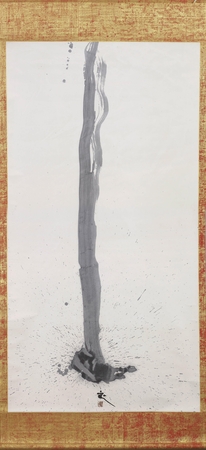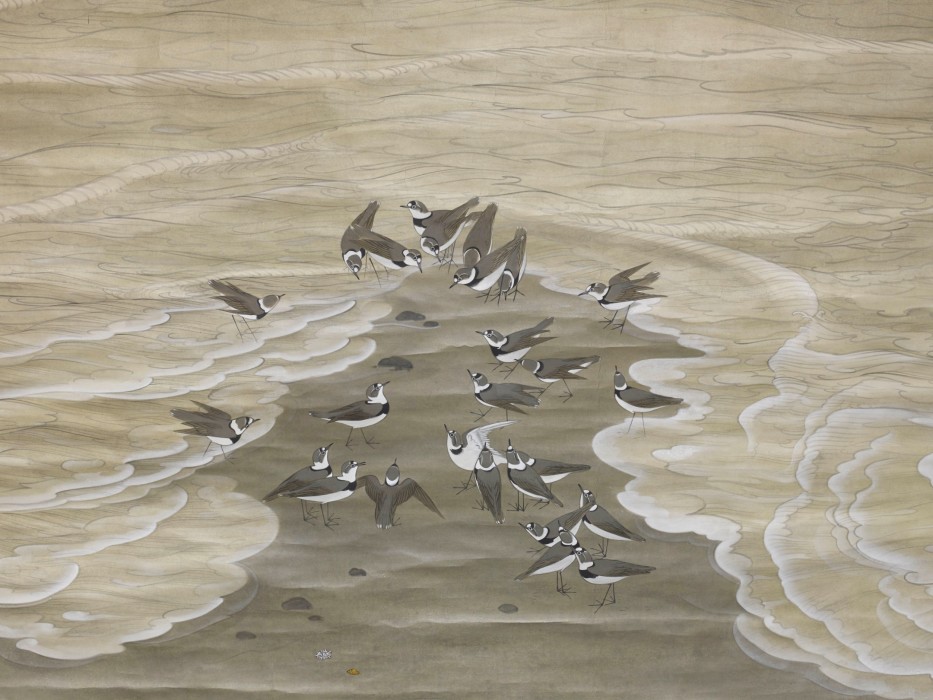Product Description
7723 Ryoji Koie (b.1938)
A large paper kakemono (hanging scroll) painted in ink with a single brush stroke as an abstract form of fire
Signed: Ryo
Seal: Koie
Titled: Honoo (Fire)
Japan 21st century
Dimensions:
Painting: H. 180.5cm x W. 94.5cm (71¼” x 37¼”)
Scroll: H. 220cm x W. 109cm (86¾” x 43″)
Tomobako (original box) inscribed:
Lid: titled Honoho (Fire)
Lid interior: signed Ryo and sealed Ryoji in (seal of Ryoji)
This contemporary painting by Ryoji Koie (b.1938) is a clear example of the artist’s ebullient personality. Although famous for his ceramic art, he never misses the opportunity to surprise his admirers by betraying their expectations and producing something different, be it in ceramic or another medium.
A single stroke of calligraphy captures the power and rhythm of fire which the artist uses while creating ceramic works in his studio in Tokoname. In order to cope with his extremely busy schedule and continue to produce work, Koie has said that he drinks, creates and sleeps cyclically at irregular intervals. “I don’t work without drinking. So I do my job while drinking, and when I get tired from drinking too much, I go to bed. Then, when I wake up, I start drinking and working. I keep on repeating that.” Interview by Yokoya Hideko 2002
Ryoji Koie was born in Tokoname City, Aichi Prefecture in 1938 and is considered one of Japan’s most innovative and avant-garde ceramicists. He has exhibited and participated in numerous workshops around the world with a flexible attitude and a power transcending international borders.
Apart from his well-known clay ceramics rendered in the classical Oribe-style with its green copper glaze, Koie is famous for adopting a variety of styles and art disciplines, from happenings with raw earth to significant works of social commentary which raise the eyebrows of the traditional ceramic establishment. He enjoys innovation whether through his paintings or via the surface of his pots. It is in this flexible approach between materials and styles that he shows his rebellious character. While his work reflects all the pleasure and value associated with the Japanese sense of beauty, there is in them a break with tradition.
Koie started producing his own pottery in 1957 soon after graduating high school and before entering the Tokoname Ceramic Art Institute. During his busy career he has won numerous awards:
3rd Prize in the Contemporary Japanese Ceramics Exhibition (1962)
Point and Line accepted, Asahi Ceramic Art Exhibition (1963-69)
Japanese Contemporary Craft Art Exhibition (1963-64)
Grand Prix, 3rd Biannual International Ceramics Exhibition, Vallauris, France (1971) 3rd Oribe Award (2001)
Chunichi Cultural Award (2005)
Gold Prize, the Japan Ceramic Society Award (2008)
Koie has travelled extensively and has produced works in America, Britain, Italy, Mexico and South Korea. A member of the International Academy of Ceramics (IAC) since 1980, his work has been exhibited in the Smithsonian Museum in Washington, D.C., the Victoria & Albert Museum in London, the Centre National de Georges Pompidou in Paris, the Metropolitan Museum of Art in New York and the Seoul Metropolitan Museum of Art. In 2002 he completed building a twenty-meter anagama (single-chamber kiln) in his hometown Okujo in Tokoname, which was specifically made to fire uneven ceramics.
Works by the artist can be found in the collections of: Victoria and Albert Museum, London; New South Wales Art Gallery, Australia; Hiroshima City Museum of Contemporary Art; Idemitsu Museum; Kyung Sung University Museum, Pusan; Metropolitan Museum of Art, Seoul; Musée Ariana, Geneva; Museo internazionale delle Ceramiche, Faenza, Italy; Museum of Fine Arts, Gifu; Museum of Modern Art, Buenos Aires; The National Museum of Modern Art, Tokyo; The National Museum of Modern Art, Kyoto; National Gallery of Victoria, Australia; River Retreat Garaku, Toyama; Seoul Museum of Art; Tokoname City Hall, Aichi; Yamaguchi Prefectural Museum of Art.








